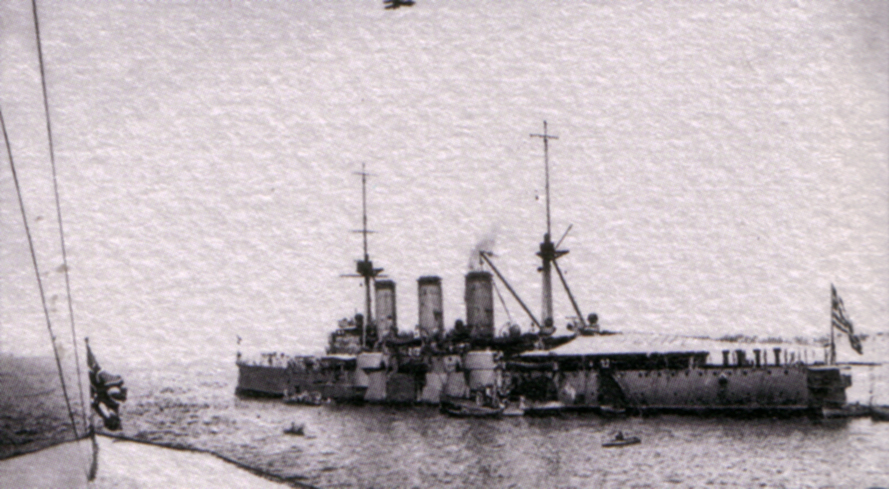Greek cruiser Georgios Averof
Template:Infobox Hellenic Navy The HS Georgios Averof (Greek ΠΝ Γεώργιος Αβέρωφ) was a Greek cruiser which served as the flagship of the Hellenic Navy during the Balkan Wars.
History
At the beginning of the 20th century, Greece decided to reinforce its fleet, whose ships were fast becoming obsolete due to the fast-moving naval arms race of the era. The authorities procured four destroyers (then a relatively new type of ship), but the most important addition was the Averof. The vessel was being built at Orlando Shipyards, at Livorno in Italy when the Italian government cancelled the project due to budgetary concerns. The Greek government immediately stepped in and acquired the ship with a 1/3 down payment, paid with the help of a wealthy Greek benefactor, George Averoff, whose name it received.
The ship was launched on March 12, 1910 and sailed in Faliron, near Athens, on September 1, 1911. Averof was at the time the most modern and powerful ship in the navies of either the Balkan League or the Ottoman Empire. As such, with the outbreak of the First Balkan War it took part, as the flagship of the Hellenic Royal Navy under the command of Rear Admiral Pavlos Kountouriotis, in the liberation of the islands of the northern and eastern Aegean. During the naval battles at Elli (December 3, 1912) and at the Battle of Lemnos (January 5, 1913) against the Ottoman Navy, it almost single-handedly secured victory and the undisputed control of the Aegean Sea for Greece. In both battles she left battleship line and pursued alone the turkish fleet, in the Naval Battle of Elli Pavlos Kountouriotis hoisted the Flag Signal for letter Z which mean in that era Greek Navy's signal code "My maneuvers being indepedent", to protect the older battleships from following Averof and put themseves in danger due to lack of armour and speed compared to Averof, and sailed with a speed of 18 knots (superior from both the turkish and the other greek battleships) against turkish fleet. These exploits propelled the ship and its Admiral to legendary status in Greece, while the Turks nicknamed it the 'devil ship'.
After WWI, Averof sailed among other Allied ships to Constantinople, receiving an ecstatic welcome from the city's Greeks. It continued as the flagship of the RHN, participating in landings in Eastern Thrace and bombardments of the Turkish Black Sea shore during the Greco-Turkish War (1919-1922) and helped in the evacuation of the refugees after the Greek Army's catastrophic defeat. In 1920s received magor reconstruction in which received monder Anti Aircraft armament, a new foremast with improved fire control equipment and removal of obsolete torpedo tubes. After Germany's attack against Greece in 1941 and the collapse of the front, Averof sailed to Alexandria, Egypt with the rest of the fleet. Actualy the ship's crew disobeyed the headquarters order to scuttle the ship to avoid her capture from germans, and sailed for a suicide trip under the threat of german air strikes (like that sunk HMS Kelly (F01), the ship commanded by Lord Louis Mountbatten, and many greek and british warships during the same operation of evaquation of Greece from British Fleet) note that the Commanding Officer of ship embarked from a rope ladder when the ship was allready underway. During the next years it was assigned to convoy escort and patrol duties in the Indian Ocean, based at Bombay and Port Said. On October 17, 1944, once again as the flagship of the exiled Hellenic Navy, it carried the Greek government-in-exile back to liberated Athens. The ship was decomissioned in 1952 and anchored at Poros from 1956 to 1983. In 1984, the Navy decided to restore it as a museum, and in the same year it was towed to Faliron, where it is anchored up to this day as 'ship in active service' with mission the historical consolidation and keep alive a sence of the Greek Navy's heritage, note in photo in [1] the Rear Admiral Rank Flag (flag which means that the ship is a flag ship of a Rear Admiral) on the mainmast displacing Masthead Pennant (a long triangular blue flag, with base to height ratio 2 to 15, with a white couped Greek cross near the hoist, flown in all Greek Navy Ships and establishments in commission, unless displaced by a senior officer's flag).
See also
External links
File:Averof Balkan.jpg
 File:Averof Reconstucted.jpg
File:Averof Reconstucted.jpg
